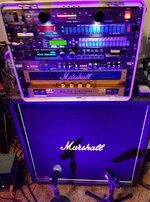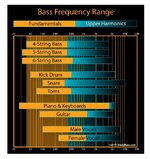those figures look liks suggestions to high pass instruments in busy mixes.
a piano extends much lower than guitar because it can play notes as low as bass guitar. Id high pass piano at 40hz if at all if it was a featured instrument
a clap should have a lot of nice stuff at 200hz, a Hihat even has stuff at 800hz even which people like to boost
sax should have lots of nice stuff way above 2khz.
Where did you find those figures? Definitely just high pass up until you hear when it is taking something away from the instrument a little and then back it off!
Edit: ah, that latest image you posted just proved my point
I used to Low Pass a lot because I loved the sound of warmth and no harshness. In the end though, it's better to Low pass to remove the junk but nice shelf cuts to TURN DOWN those higher frequencies to correct balance. So Low passing guitars at 3khz is too aggressive, it will sound much better if you low pass at 8khz but turn down the 3khz-8khz with a shelf or the guitar will sound unnatural. Keep a few elements of your mix bright, but the stuff you want in the back turned down in those presence frequencies eg: 3khz and above.
If you low pass everything too aggressive, I think you will really struggle to get a nice balanced mix. I do know why you are doing moves like this, because I have been through it all myself. I found that I was very dissapointed every time with the end result, especially when listening to nice bright open mixes of the same songs.
I'm going to have to duck out of this thread for a bit. I have a lot of work coming up and I need to concentrate on that for now.
Oh, a LPF at 5khz is a standard thing I do on bass guitar, which the image above is pretty much spot on there. but 8khz LPF even on the nastiest harshest electric guitar is pretty much the maximum I'd go. It would be big bell cuts or shelf filters to just turn that nasty high end down from there on. Try doing that. Or don't! Low pass at your 3khz if you are determined, Sometimes it's better to find out for yourself! Just keep in mind what I suggest and please do try this also and see what mix you end up liking more. I'd put money on it being the controlled high end though.
One other note, if you low pass at 3khz on electric guitars, then you lose ALL control of being able to brighten up the guitar further down the line if you need it, and backing off the low pass filter to bring back brightness will NOT work because that high end you didn't like will just come back. So this is another reason why It's really great to just turn down that high end, you can get away with a lot more around the presence frequencies, essentially you can keep almost the entire songs tracks frequencies overlapping around that but that area does need to be tightly controlled, there is a fine balance. Just keep on at it! You're only going to learn so much from each attempt. And sometimes it will feel like you are getting worse at it because you start to use more tools (wrong). I think we all go through it. And is a very natural process.
Forget what the fucking waveforms look like though. Pointless. I look at the waveforms only to make sure my phase is correct. and I even only reall care about that for the drums, to make sure the spot mics are in phase with the OH's. And with the Bass guitar if I record DI and Amp together, those waveforms will always be wrong and for low end instruments phase is important.




